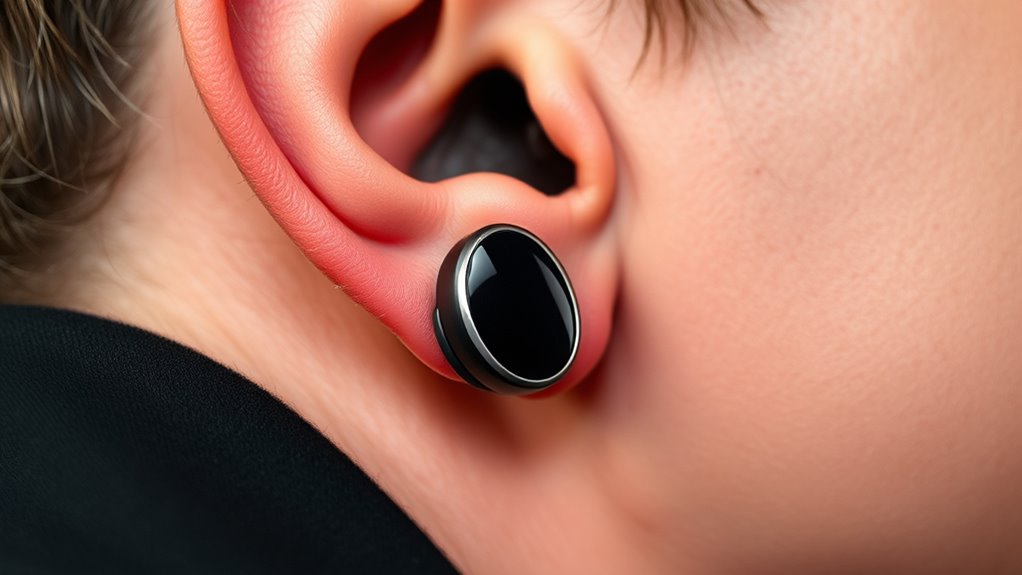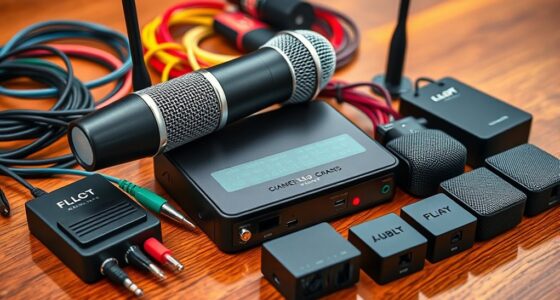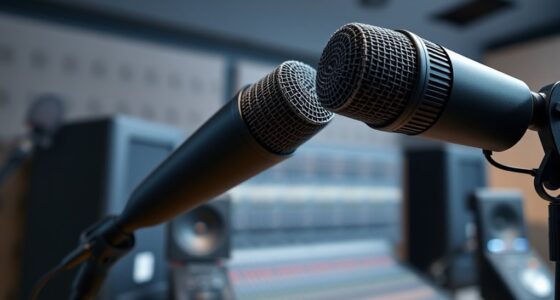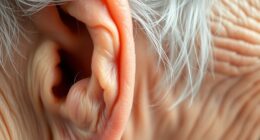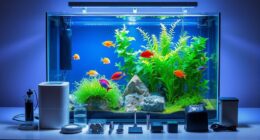High-fidelity hearing solutions let you enjoy authentic sound quality while protecting your ears during gigs or studio work. Unlike traditional earplugs that dull all sounds, these use special filters to balance attenuation, preserving clarity and detail. They reduce harmful volume levels without muffling music, helping you hear subtle nuances and maintain audio fidelity. Designed for comfort and discretion, they support your focus and performance. Keep going to discover how these tech advances elevate your musical experience.
Key Takeaways
- High-fidelity hearing protection preserves sound clarity and detail, enabling musicians to hear their performances accurately without muffling nuances.
- Engineered filters in these devices attenuate loud sounds evenly across frequencies, maintaining audio fidelity during live or studio sessions.
- Compared to traditional earplugs, high-fidelity solutions reduce harmful noise levels while keeping music natural and transparent.
- Designed for comfort and discreetness, they allow extended wear during rehearsals, performances, or recording sessions without discomfort.
- Using high-fidelity hearing tech enhances critical listening, sound perception, and long-term ear safety for musicians and audio professionals.
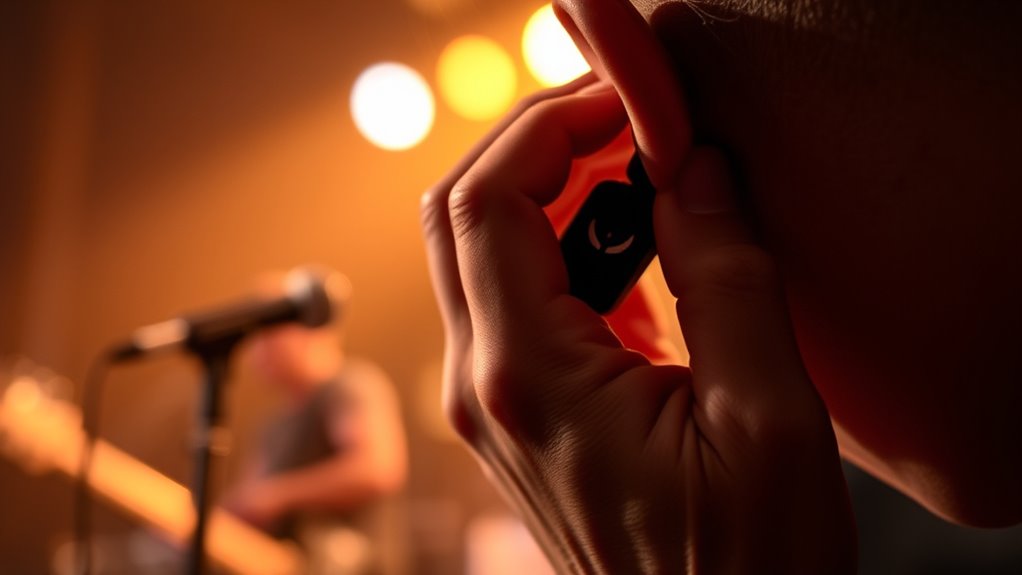
Have you ever wondered how musicians protect their hearing without sacrificing sound quality? The answer lies in advanced hearing tech designed specifically for your needs. High-fidelity ear protection offers a way to safeguard your ears while still allowing you to experience music as it was meant to be heard. Unlike traditional earplugs, these devices focus on maintaining sound clarity and detail, which is essential for musicians who rely on precise audio cues. When you’re on stage or in the studio, sound isolation becomes a top priority. You need to reduce harmful volume levels without muffling the nuances that make your performance or recordings exceptional. High-fidelity musicians’ earplugs are engineered to attenuate loud sounds evenly across frequencies, preserving the audio fidelity so that you don’t lose the richness or depth of your sound. This means you hear your music clearly and accurately, just as your audience will, but with the added benefit of protecting your hearing over time.
The key to this technology is its ability to strike a balance between sound isolation and audio fidelity. Traditional ear protection often diminishes all sounds equally, which can make music sound dull or distant. High-fidelity solutions, however, use special filters that allow you to hear a natural, balanced sound while reducing volume to safe levels. This way, you stay alert to subtle cues, whether you’re tuning your instrument on stage or mixing in the studio. You won’t have to compromise the quality of your sound to prevent hearing damage. Instead, you get a protective layer that filters out damaging noise without sacrificing the details that are essential for your performance or listening experience. Incorporating vertical storage solutions can help keep your gear organized and easily accessible, supporting your focus and efficiency.
Moreover, these hearing tech devices are designed to be comfortable for extended wear. You can insert them during long rehearsals or performances, knowing your ears are shielded without feeling bulky or intrusive. They are discreet, so no one will notice you’re wearing them, allowing you to focus fully on your craft. The improved sound isolation helps you concentrate, cut out background noise, and stay in the zone. With these high-fidelity earplugs, you’re not just protecting your ears; you’re also enhancing your ability to listen critically and perform at your best. Ultimately, this technology empowers you to enjoy your music safely while maintaining the integrity of your sound, ensuring your musical journey remains sustainable and rewarding.
Frequently Asked Questions
How Do Hearing Aids Differ From Musician-Specific In-Ear Monitors?
Hearing aids differ from musician-specific in-ear monitors mainly in personalization and sound quality. Hearing aids are designed for everyday use, focusing on amplification and speech clarity, often with less tailored sound profiles. In contrast, musician monitors are customized for high-fidelity sound, emphasizing accurate, balanced audio. You’ll notice sound quality variations, with musician monitors offering clearer, more detailed audio, and personalization differences catering to your specific hearing needs and performance environment.
Can Hearing Tech Prevent Long-Term Hearing Damage During Performances?
Think of hearing tech as your shield in a noisy battlefield. It can help prevent hearing loss by providing customized volume control and noise reduction, making it easier to protect your ears during performances. Using advanced hearing tech supports hearing conservation, reducing the risk of long-term damage. While it’s not a magic bullet, it’s a essential tool to keep your hearing safe, so you can perform at your best for years to come.
Are High-Fidelity Hearing Solutions Suitable for All Music Genres?
High-fidelity hearing solutions are suitable for many music genres because they offer customizable sound and a broad frequency response. You can tailor the sound to match your specific genre, whether it’s classical, rock, or electronic. This personalization guarantees you experience clear, accurate audio without distortion. While not perfect for every style, these solutions generally enhance your listening experience across various genres, helping protect your hearing while enjoying music at its best.
What Maintenance Is Required for Advanced Hearing Tech Used by Musicians?
Think of your advanced hearing tech as a finely tuned instrument—you need to keep it in good shape. Regularly check the battery lifespan to avoid sudden silence, and replace batteries as needed. Keep the device updated with the latest software to guarantee peak performance and security. Gently clean your hearing tech and store it properly when not in use. With proper maintenance, your high-fidelity experience will stay crystal-clear and reliable.
How Do Hearing Devices Integrate With Existing Stage and Studio Equipment?
You connect hearing devices to stage and studio equipment through wireless connectivity, making setups seamless. The devices use signal processing to guarantee clear audio, filtering out unwanted noise. Simply pair your hearing tech via Bluetooth or other wireless protocols, then adjust settings for ideal sound. This integration allows you to monitor and control audio directly, enhancing your performance or recording experience without cumbersome cables or complicated configurations.
Conclusion
Just like Apollo protected the ears of musicians in myth, today’s high-fidelity hearing tech shields your hearing while enhancing your sound. Embrace these solutions, and you’ll keep your senses sharp, ensuring your passion for music endures like the timeless stories of old. Don’t wait for the siren’s call of hearing loss—invest in your future now. After all, safeguarding your hearing is the true symphony of a lifelong musical journey.

